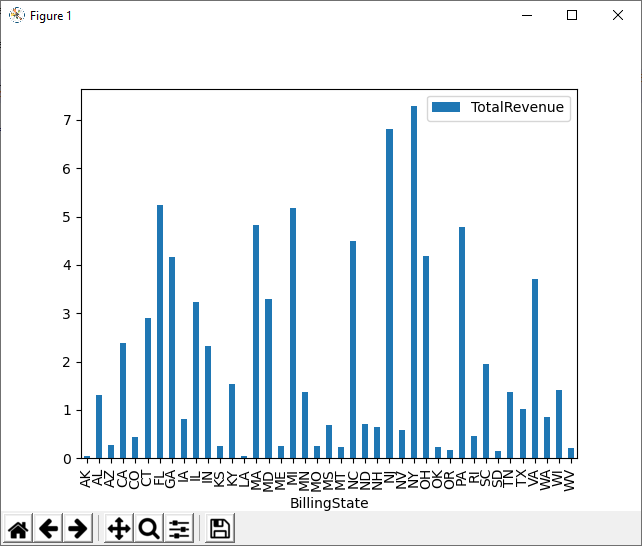Discover how a bimodal integration strategy can address the major data management challenges facing your organization today.
Get the Report →How to Visualize Zuora Data in Python with pandas
Use pandas and other modules to analyze and visualize live Zuora data in Python.
The rich ecosystem of Python modules lets you get to work quickly and integrate your systems more effectively. With the CData Python Connector for Zuora, the pandas & Matplotlib modules, and the SQLAlchemy toolkit, you can build Zuora-connected Python applications and scripts for visualizing Zuora data. This article shows how to use the pandas, SQLAlchemy, and Matplotlib built-in functions to connect to Zuora data, execute queries, and visualize the results.
With built-in optimized data processing, the CData Python Connector offers unmatched performance for interacting with live Zuora data in Python. When you issue complex SQL queries from Zuora, the driver pushes supported SQL operations, like filters and aggregations, directly to Zuora and utilizes the embedded SQL engine to process unsupported operations client-side (often SQL functions and JOIN operations).
Connecting to Zuora Data
Connecting to Zuora data looks just like connecting to any relational data source. Create a connection string using the required connection properties. For this article, you will pass the connection string as a parameter to the create_engine function.
Zuora uses the OAuth standard to authenticate users. See the online Help documentation for a full OAuth authentication guide.
Configuring Tenant property
In order to create a valid connection with the provider you need to choose one of the Tenant values (USProduction by default) which matches your account configuration. The following is a list with the available options:
- USProduction: Requests sent to https://rest.zuora.com.
- USAPISandbox: Requests sent to https://rest.apisandbox.zuora.com"
- USPerformanceTest: Requests sent to https://rest.pt1.zuora.com"
- EUProduction: Requests sent to https://rest.eu.zuora.com"
- EUSandbox: Requests sent to https://rest.sandbox.eu.zuora.com"
Selecting a Zuora Service
Two Zuora services are available: Data Query and AQuA API. By default ZuoraService is set to AQuADataExport.
DataQuery
The Data Query feature enables you to export data from your Zuora tenant by performing asynchronous, read-only SQL queries. We recommend to use this service for quick lightweight SQL queries.
Limitations- The maximum number of input records per table after filters have been applied: 1,000,000
- The maximum number of output records: 100,000
- The maximum number of simultaneous queries submitted for execution per tenant: 5
- The maximum number of queued queries submitted for execution after reaching the limitation of simultaneous queries per tenant: 10
- The maximum processing time for each query in hours: 1
- The maximum size of memory allocated to each query in GB: 2
- The maximum number of indices when using Index Join, in other words, the maximum number of records being returned by the left table based on the unique value used in the WHERE clause when using Index Join: 20,000
AQuADataExport
AQuA API export is designed to export all the records for all the objects ( tables ). AQuA query jobs have the following limitations:
Limitations- If a query in an AQuA job is executed longer than 8 hours, this job will be killed automatically.
- The killed AQuA job can be retried three times before returned as failed.
Follow the procedure below to install the required modules and start accessing Zuora through Python objects.
Install Required Modules
Use the pip utility to install the pandas & Matplotlib modules and the SQLAlchemy toolkit:
pip install pandas pip install matplotlib pip install sqlalchemy
Be sure to import the module with the following:
import pandas import matplotlib.pyplot as plt from sqlalchemy import create_engine
Visualize Zuora Data in Python
You can now connect with a connection string. Use the create_engine function to create an Engine for working with Zuora data.
engine = create_engine("zuora:///?OAuthClientID=MyOAuthClientId&OAuthClientSecret=MyOAuthClientSecret&Tenant=USProduction&ZuoraService=DataQuery&InitiateOAuth=GETANDREFRESH&OAuthSettingsLocation=/PATH/TO/OAuthSettings.txt")
Execute SQL to Zuora
Use the read_sql function from pandas to execute any SQL statement and store the resultset in a DataFrame.
df = pandas.read_sql("SELECT Id, BillingCity FROM Invoices WHERE BillingState = 'CA'", engine)
Visualize Zuora Data
With the query results stored in a DataFrame, use the plot function to build a chart to display the Zuora data. The show method displays the chart in a new window.
df.plot(kind="bar", x="Id", y="BillingCity") plt.show()

Free Trial & More Information
Download a free, 30-day trial of the CData Python Connector for Zuora to start building Python apps and scripts with connectivity to Zuora data. Reach out to our Support Team if you have any questions.
Full Source Code
import pandas
import matplotlib.pyplot as plt
from sqlalchemy import create_engin
engine = create_engine("zuora:///?OAuthClientID=MyOAuthClientId&OAuthClientSecret=MyOAuthClientSecret&Tenant=USProduction&ZuoraService=DataQuery&InitiateOAuth=GETANDREFRESH&OAuthSettingsLocation=/PATH/TO/OAuthSettings.txt")
df = pandas.read_sql("SELECT Id, BillingCity FROM Invoices WHERE BillingState = 'CA'", engine)
df.plot(kind="bar", x="Id", y="BillingCity")
plt.show()






